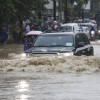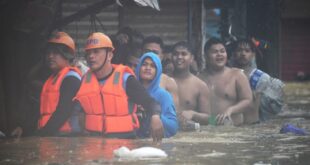Climate change, a rising population and excessive exploitation of groundwater are putting pressure on the clean water supplies of Ho Chi Minh City, experts have warned.
Bui Thanh Giang, Deputy General Director of state-owned Saigon Water Corporation (SAWACO), said at a meeting Tuesday the city is facing multiple challenges in supplying clean and safe water, including excessive exploitation of groundwater.
“Up to 16% of the city’s households used groundwater extracted from wells last year. The figure was 15% in the first five months of this year,” he said.
Around 94% of the city’s water comes from the Saigon River and the Dong Nai River, which is home to a number of factories and industrial parks discharging wastewater into the rivers, with many of them lacking advanced wastewater treatment technology.
The city also lacks reserve reservoirs to store clean water in case of water shortages, he added.
The company currently supplies clean water to households in almost all districts (except for Cu Chi District, which is supplied by Water Infrastructure JSC) and Thu Duc City, he said.
It targets increasing the average supply of water per capita per day by 165 liters and reducing the tap water leakage rate to 15% by 2025.
By then, the city water supply capacity will reach 3.6 million cu.m per day, using only 100,000 cu.m of groundwater.
Climate change
Dr. Nguyen Minh Hoa, senior lecturer at the Faculty of Urban Studies of HCMC University of Social Sciences and Humanities, said climate change might disrupt the city’s water resources.
Climate change will affect where, when, and how much water is available, which can harm the health of people and ecosystems, he said.
These impacts are especially likely to happen in the country’s low-lying areas such as the Cuu Long (Mekong) Delta and HCMC, he said.
Experts have warned if the sea level rises by 0.7-1m, the entire Mekong Delta region and 72% of HCM City’s area will be under water.
Climate change also threatens to increase the salinity of water and groundwater through saltwater intrusion, he said.
Drought is likely to cause reservoirs such as Tri An and Dau Tieng to dry up.
People’s demand for freshwater is on the rise due to a rising population. The city’s population on average increases by 250,000 people every year (mostly migrants coming to the city for work). Its population is expected to reach 10 million by 2030 and 15 million by 2050.
The city is expected to receive 8-10 million international tourists and 15-20 million domestic tourists per year.
Its water supply will need to increase to meet the demand for 200-300 liters of water per person per day.
The creation of new urban areas will also require a larger and stronger water supply system.
To help reduce climate risks, experts said the city should consider potential impacts on their systems and take steps to build resilience.
People can also take steps to use water efficiently and help keep bodies of water clean, they said.
Water supply works in industrial parks and other business establishments must be closely monitored to prevent groundwater exploitation.
The city’s Department of Natural Resources and Environment needs to carry out inspections, risk management, and preparations for incidents or disasters related to water supply and water security.
The city will need to call for additional investment in a clean water supply system.
The government last year approved a resilience project specifically focused on water resources developed by the Ministry of Agriculture and Rural Development.
- Reduce Hair Loss with PURA D’OR Gold Label Shampoo
- Castor Oil Has Made a “Huge” Difference With Hair and Brow Growth
- Excessive hair loss in men: Signs of illness that cannot be subjective
- Dịch Vụ SEO Website ở Los Angeles, CA: đưa trang web doanh nghiệp bạn lên top Google
- Nails Salon Sierra Madre
 VnExpress News The News Gateway of Vietnam
VnExpress News The News Gateway of Vietnam





